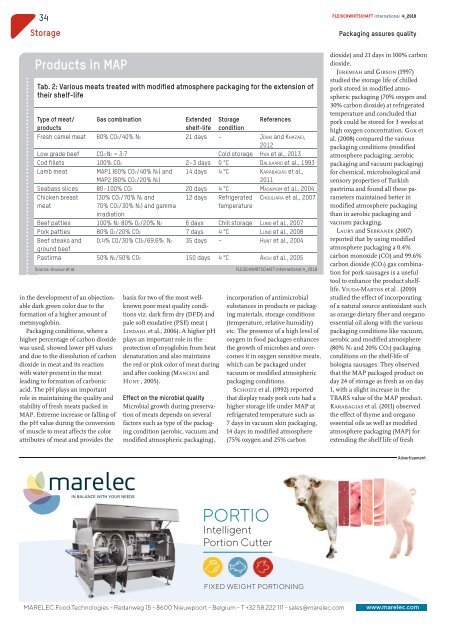FLEISCHWIRTSCHAFT international_04_2018
- No tags were found...
You also want an ePaper? Increase the reach of your titles
YUMPU automatically turns print PDFs into web optimized ePapers that Google loves.
................................................................................................................................................................<br />
34<br />
Fleischwirtschaft <strong>international</strong> 4_<strong>2018</strong><br />
Storage<br />
Packaging assures quality<br />
Products in MAP<br />
Tab. 2: Various meats treated with modified atmosphere packaging for the extension of<br />
their shelf-life<br />
Type of meat/ Gas combination<br />
Extended Storage References<br />
products<br />
shelf-life condition<br />
Fresh camel meat 60% CO2/40% N2 21 days – JOUKI and KHAZAEI,<br />
2012<br />
Low grade beef CO2:N2 = 3:7 Cold storage HUR et al., 2013<br />
Cod fillets 100% CO2 2–3 days 0°C DALGAARD et al., 1993<br />
Lamb meat MAP1 (60% CO2/40% N2) and<br />
MAP2 (80% CO2/20% N2)<br />
14 days 4°C KARABAGIAS et al.,<br />
2011<br />
Seabass slices 80–100% CO2 20 days 4°C MASNIYOM et al., 20<strong>04</strong><br />
Chicken breast (30% CO2/70% N2 and 12 days Refrigerated CHOULIARA et al., 2007<br />
meat<br />
70% CO2/30% N2) and gamma<br />
irradiation<br />
temperature<br />
Beef patties 100% N2; 80% O2/20% N2 6days Chill storage LUND et al., 2007<br />
Pork patties 80% O2/20% CO2 7days 4°C LUND et al., 2008<br />
Beef steaks and 0.4% CO/30% CO2/69.6% N2 35 days – HUNT et al., 20<strong>04</strong><br />
ground beef<br />
Pastirma 50% N2/50% CO2 150 days 4°C AKSU et al., 2005<br />
Source: UMARAW et al. <strong>FLEISCHWIRTSCHAFT</strong> <strong>international</strong> 4_<strong>2018</strong><br />
in the development of an objectionable<br />
dark green color due to the<br />
formation of a higher amount of<br />
metmyoglobin.<br />
Packaging conditions, where a<br />
higher percentage of carbon dioxide<br />
was used, showed lower pH values<br />
and due to the dissolution of carbon<br />
dioxide in meat and its reaction<br />
with water present in the meat<br />
leading to formation of carbonic<br />
acid. The pH plays an important<br />
role in maintaining the quality and<br />
stability of fresh meats packed in<br />
MAP. Extreme increase or falling of<br />
the pH value during the conversion<br />
of muscle to meat affects the color<br />
attributes of meat and provides the<br />
basis for two of the most wellknown<br />
poor meat quality conditions<br />
viz. dark firm dry (DFD) and<br />
pale soft exudative (PSE) meat (<br />
LINDAHL et al., 2006). A higher pH<br />
plays an important role in the<br />
protection of myoglobin from heat<br />
denaturation and also maintains<br />
the red or pink color of meat during<br />
and after cooking (MANCINI and<br />
HUNT , 2005).<br />
Effect on the microbial quality<br />
Microbial growth during preservation<br />
of meats depends on several<br />
factors such as type of the packaging<br />
condition (aerobic, vacuum and<br />
modified atmospheric packaging),<br />
incorporation of antimicrobial<br />
substances in products or packaging<br />
materials, storage conditions<br />
(temperature, relative humidity)<br />
etc. The presence of a high level of<br />
oxygen in food packages enhances<br />
the growth of microbes and overcomes<br />
it in oxygen sensitive meats,<br />
which can be packaged under<br />
vacuum or modified atmospheric<br />
packaging conditions.<br />
SCHOLTZ et al. (1992) reported<br />
that display ready pork cuts had a<br />
higher storage life under MAP at<br />
refrigerated temperature such as<br />
7days in vacuum skin packaging,<br />
14 days in modified atmosphere<br />
(75% oxygen and 25% carbon<br />
dioxide) and 21 days in 100% carbon<br />
dioxide.<br />
JEREMIAH and GIBSON (1997)<br />
studied the storage life of chilled<br />
pork stored in modified atmospheric<br />
packaging (70% oxygen and<br />
30% carbon dioxide) at refrigerated<br />
temperature and concluded that<br />
pork could be stored for 3weeks at<br />
high oxygen concentration. GOK et<br />
al. (2008) compared the various<br />
packaging conditions (modified<br />
atmosphere packaging, aerobic<br />
packaging and vacuum packaging)<br />
for chemical, microbiological and<br />
sensory properties of Turkish<br />
pastrima and found all these parameters<br />
maintained better in<br />
modified atmosphere packaging<br />
than in aerobic packaging and<br />
vacuum packaging.<br />
LAURY and SEBRANEK (2007)<br />
reported that by using modified<br />
atmosphere packaging a 0.4%<br />
carbon monoxide (CO) and 99.6%<br />
carbon dioxide (CO2) gas combination<br />
for pork sausages is a useful<br />
tool to enhance the product shelflife.<br />
VIUDA-MARTOS et al . (2010)<br />
studied the effect of incorporating<br />
of a natural source antioxidant such<br />
as orange dietary fiber and oregano<br />
essential oil along with the various<br />
packaging conditions like vacuum,<br />
aerobic and modified atmosphere<br />
(80% N2 and 20% CO2) packaging<br />
conditions on the shelf-life of<br />
bologna sausages. They observed<br />
that the MAP packaged product on<br />
day 24 of storage as fresh as on day<br />
1, with a slight increase in the<br />
TBARS value of the MAP product.<br />
KARABAGIAS et al. (2011) observed<br />
the effect of thyme and oregano<br />
essential oils as well as modified<br />
atmosphere packaging (MAP) for<br />
extending the shelf life of fresh<br />
Advertisement

















